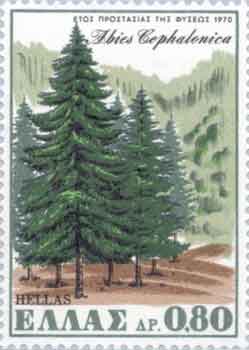|
|
Abies Cephalonica
Greek Fir (Abies cephalonica) is a fir native to the mountains of Greece, primarily in the Peloponnesos and the island of Kefallinia, intergrading with the closely related Bulgarian Fir further north in the Pindus mountains of northern Greece. It is a medium-size evergreen coniferous tree growing to 25-35 m (rarely 40 m) tall and with a trunk diameter of up to 1 m. It occurs at altitudes of 900-1,700 m, on mountains with a rainfall of over 1,000 mm. The leaves are needle-like, flattened, 1.5-3 cm long and 2 mm wide by 0.5 mm thick, glossy dark green above, and with two blue-white bands of stomata below. The tip of the leaf is pointed, usually fairly sharply but sometimes with a blunt tip, particularly on slow-growing shoots on older trees. The cones are 10-20 cm long and 4 cm broad, with about 150-200 scales, each scale with an exserted bract and two winged seeds; they disintegrate when mature to release the seeds. It is also closely related to Nordmann Fir to the east in northern Turkey. Uses Greek Fir was important in the past for wood for general construction, but it is too rare to be of significant value now. It is also grown as an ornamental tree in parks and large gardens, though in areas that often get late frosts it is prone to frost damage, as it is one of the first conifers to come to leaf in spring. Links Photos of trees in Peloponnesos, Greece (captions in Italian; "abete" = Greek Fir, "pino nero" = Black Pine)
Retrieved from "http://en.wikipedia.org/" |
|
